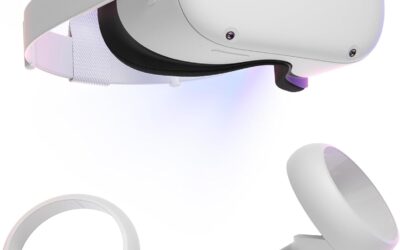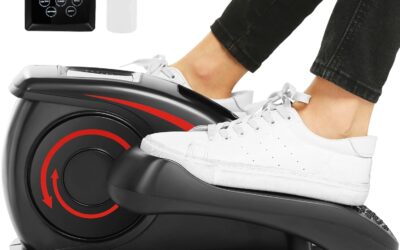Which VR headset is the right choice for you: the Meta Quest 2 vs Meta Quest 3? The Quest 2 has become needing the leading VR headset in today’s market. If you’re reading this, chances are you either already own a Quest 2 or have experience using one, and you’re now considering whether Meta’s latest release, the Quest 3, is worth the upgrade.
Table of Contents
ToggleFirstly, both the Meta Quest 2 and the Meta Quest 3 are standalone VR headsets, offering virtual and mixed-reality experiences without the need for a connection to a high-end gaming PC. While it’s possible to connect them to a PC for playing PC VR games, their standalone functionality is a significant draw. This stands in contrast to other VR headsets like the Valve Index, which cost more than the Quest 3 and require a gaming PC for operation. The Quest headsets’ standalone capability and affordable pricing have contributed to their widespread popularity.

Pricing
Priced at not less than $490.00 US for the 128GB model and not less than $640.00 for the 512GB model, the Quest 3 commands roughly twice the cost of a Quest 2. The question arises: what additional features justify this higher price tag? To begin, let’s examine the contents of each headset’s packaging. Alongside the headset itself, both versions include a pair of controllers.
What comes in the box
In the box, both the Quest 2 and Quest 3 include the headset itself, a pair of controllers, and a USB-C charging cable along with a wall adapter. However, the Quest 2 also comes with additional accessories such as a glasses spacer and a rubber cover for the facial interface, which is absent in the Quest 3. This difference is because the facial interface of the Quest 3 is adjustable, eliminating the need for a separate glasses spacer. This adjustment feature not only streamlines the setup process but also reduces the risk of losing or damaging the spacer.
Facial Interface
Looking at the Meta Quest 2 vs Meta Quest 3. The facial interface of the Quest 2 is crafted from foam material, which, while comfortable, has the downside of absorbing sweat, making it less appealing for shared use and potentially causing allergic reactions in some users. To address this issue and facilitate easier cleaning, a rubber cover can be utilized, although it compromises comfort. Personally, I prefer aftermarket facial interfaces made from PU leather for enhanced comfort, although they are not included with the headset. In contrast, the Quest 3 features a cloth material facial interface, initially feeling stiff but becoming more comfortable with use. However, like its predecessor, it also suffers from sweat absorption issues, prompting me to await VR Cover’s official Quest 3 interface release for a replacement.
Lenses
Moving on to the lenses, the Quest 3 boasts a significant improvement over the Quest 2. While the Quest 2 utilizes Fresnel lenses with visible concentric rings and a smaller sweet spot, the Quest 3 employs pancake lenses offering a larger sweet spot. For those unfamiliar, the sweet spot refers to the area in the lenses where one must position their eyes to achieve optimal focus. Quest 2 users are familiar with the challenge of locating this small sweet spot, often requiring meticulous adjustment of the headset. In contrast, the Quest 3’s lenses feature a noticeably larger sweet spot, making it easier to find and offering greater forgiveness in adjustment.

IP Adjustment of Meta Quest 2 vs Meta Quest 3
When it comes to locating the sweet spot in the lenses, the distance between your pupils, known as IPD (interpupillary distance), plays a crucial role. Both the Quest 2 and Quest 3 feature IPD adjustment to accommodate variations in this distance among users. The Quest 2 offers three preset positions, which suit most individuals, but may not be ideal for everyone. Users with IPD falling between two preset settings may find it challenging to achieve optimal adjustment, as the lenses are not designed for intermediate positions. In contrast, the Quest 3 boasts an IPD adjustment wheel located on the underside of the headset, allowing users to fine-tune the IPD anywhere between 58 and 70mm while wearing the device. This adjustment is displayed within the headset, providing real-time feedback as users adjust it.
HeadStrap
Moving on to the head strap, While the stock strap for the Quest 3 is marginally better than its predecessor, it’s quickly replaced with a third-party option. Though third-party straps were not available immediately after the Quest 3’s launch, innovative individuals swiftly created 3D printable adapters, enabling the use of Quest 2 head straps with the Quest 3 until suitable replacements were found.
Regarding the controllers, the Quest 3’s controllers are slightly smaller and lighter than those of the Quest 2, primarily due to the absence of tracking rings. Additionally, the Quest 3’s controllers offer slightly stronger haptic feedback compared to the Quest 2, whose haptics may go unnoticed due to their weak intensity. Both the Quest 2 and Quest 3 controllers boast exceptional battery life, with each controller powered by a single AA battery lasting an impressively long time. Based researches conducted, usage and battery percentage, the controllers of both models can last approximately 40 to 50 hours on a single battery, demonstrating remarkable longevity.
Hand Tracking
the Meta Quest 2 vs Meta Quest 3 offer support for hand tracking, enabling users to navigate menus and even engage in certain games without the need for controllers.
Weight
The Meta 2 is marginally lighter than the Meta 3, weighing in at 17.7 ounces or 503 grams, whereas the Quest 3 weighs 18.2 ounces or 515 grams. However, despite its slightly heavier weight, the Quest 3 doesn’t feel noticeably heavier. This is because Meta has made the Quest 3 40% slimmer than its predecessor, the Meta 2. Consequently, with the weight of the unit closer to the face, the balance is improved, creating a sensation of lightness. It’s worth noting that the 40% slimmer design does not include the facial interface. When comparing the devices with the facial interfaces attached, they appear to be quite similar in size. However, upon removing the interfaces, a noticeable difference in thickness becomes apparent.

Physical Difference
There are several minor physical differences between the two headsets. Both the Quest 2 and Quest 3 feature USB-C charging ports, but on the Quest 3, it has been relocated to the headband. Similarly, both headsets have 3.5mm headphone jacks, but on the Quest 3, it has been moved to the right side opposite the charging port.
The power button on the Quest 3 has been switched from the right side to the left side, while the volume rocker remains more or less the same on both devices. Additionally, the Quest 3 supports a charging dock accessory, indicated by three contact dots, whereas the Quest 2 does not offer this functionality.
Camera Setup
One of the most noticeable differences externally is the camera setup. The Meta 2 features four infrared cameras for tracking and passthrough. In contrast, the Meta 3 boasts six cameras and a depth sensor. Four of these cameras are infrared for tracking, while the other two are full-color cameras for passthrough. The inclusion of these color cameras, along with the depth sensor, provides users with precise depth perception, allowing them to interact with the real world more naturally.
Other Comparisons
When comparing the passthrough functionality between the two headsets, the Meta 3’s passthrough significantly outperforms that of the Meta 2. On both devices, activating passthrough mode is done by double-tapping the side of the headset. However, the experience differs greatly.
The Meta 2 offers a black and white representation of the real world, which is somewhat blurry and lacks detail. While it suffices for basic tasks like checking your surroundings or grabbing a drink, it’s inadequate for activities like using your phone or computer, requiring you to remove the headset.
In contrast, the Quest 3’s passthrough provides a full-color view of the real world, which is notably sharper and clearer compared to its predecessor. This improved clarity enables users to perform tasks like using their phone or computer while wearing the headset. Despite these enhancements, the passthrough on the Quest 3 still exhibits some blurriness, graininess, and distortion due to the stitching together of camera and depth sensor data.
The improved passthrough of the Meta 3 enables the headset to offer compelling mixed reality experiences. While there aren’t many mixed reality games available yet, those that exist provide glimpses of what the future holds. Some mixed reality experiences are compatible with both the Meta 2 and Meta 3, while others are exclusive to the Meta 3, leveraging its enhanced passthrough capabilities.
The Quest 3 boasts a significant enhancement in display technology, featuring a 30% increase in pixel count compared to the Quest 2. While the Quest 2 utilizes a single LCD panel with a resolution of 1832 x 1920 pixels per eye, the Quest 3 adopts dual LCD panels, one for each eye, with a resolution of 2064 x 2208 pixels per panel. Both headsets operate between 72 and 120Hz, offering smoother visuals.
This enhancement results in sharper and clearer visuals on the Quest 3, delivering a more immersive experience. Additionally, to accommodate the increased pixel count and deliver higher-quality visuals, the Quest 3 is equipped with Qualcomm’s Snapdragon XR2 Gen 2 processor. This processor offers approximately twice the GPU performance of the Snapdragon XR2 Gen 1 found in the Quest 2.
With the upgraded processor, the Quest 3 is capable of rendering higher resolutions and more detailed game environments. An exemplary demonstration of this capability is seen in games like Red Matter 2, which received an update optimized for the Quest 3. The game showcases remarkable visual fidelity on the Quest 3, with sharp and crisp graphics that rival the PC version. Despite some differences in lighting and shadow effects compared to the PC version, the Quest 3’s resolution and texture quality are equally impressive, delivering a breathtaking gaming experience.

Games Library
- Both the Quest 2 and Quest 3 have access to the same games library, with most titles available on the Quest store compatible with both headsets.
- Upgrading from the Quest 2 to the Quest 3 allows users to retain access to all their previously owned games.
- Currently, there are few Quest 3 exclusives, and it’s unlikely for developers to focus solely on Quest 3 exclusivity due to the significantly larger user base of the Quest 2.
- While some developers may optimize their games for the Quest 3’s additional power, the majority of games will run similarly on both headsets unless specifically updated.
Setting Up Play Area (Boundary)
- Both headsets require setting up a play area, known as the Boundary, before use.
- On the Quest 2, users manually draw out their play space, while the Quest 3 offers an automatic boundary feature that scans the room to determine the play space.
- Room scanning is necessary for some mixed reality experiences but not required for standard virtual reality games.
Media Consumption
- With its increased power and resolution, the Quest 3 provides a superior media consumption experience compared to the Quest 2.
- Apps like Big Screen, which allow users to watch movies and videos on a virtual screen, benefit from the Quest 3’s higher resolution, resulting in a clearer and less pixelated image.
- While watching movies and TV shows on an actual TV is preferred, the Quest 3 offers a passable experience for video content consumption, especially when compared to the Quest 2.
In summary, while both headsets offer access to the same games library and require similar setup procedures, the Quest 3 stands out with its improved media consumption experience, thanks to its increased power and resolution.
Comparing the microphones, battery life, PC VR capabilities, and overall value proposition between the Quest 2 and Quest 3:
Microphone Quality
- Both headsets have similar overall sound quality, but the Quest 3’s microphone suffers from plosives, making certain sounds cause popping noises.
- This issue likely stems from the placement of the microphones, with the Quest 3 having them behind the faceplate, causing air from speaking to directly enter the mic, unlike the Quest 2, which has side-mounted microphones.
Battery Life and Charging
- The Meta Quest 2 vs Meta Quest 3 offer approximately 2 hours of battery life.
- Over time, lithium batteries degrade, affecting their longevity. Solutions like a hot-swappable battery pack for the Quest 2 can help mitigate this issue.
- Charging time for both headsets is around 2 hours when fully depleted.
PC VR Compatibility
- Both headsets can be used for PC VR gaming.
- Quest Link allows for a wired connection between the headset and PC via a USB C cable.
- Air Link enables wireless streaming of PC VR games to the headset, requiring a connection between the PC and the WiFi router.
- The Quest 3 offers noticeably better resolution for PC VR gaming compared to the Quest 2, providing sharper and clearer visuals.
Value Proposition
- Whether the Quest 3 is worth double the cost of the Quest 2 depends on individual preferences and circumstances.
- For users seeking the best standalone VR experience, particularly with enhanced features like improved display tech and passthrough, the Quest 3 may be worth the investment.
- Existing Quest 2 owners considering an upgrade should weigh the value of the Quest 3’s enhancements against the additional cost.
- For those on a budget or new to VR, the Quest 2 offers a compelling option with a good VR experience at a more affordable price point.
Conclusion
While the Quest 3 offers several improvements over the Quest 2, including better microphone quality, enhanced display technology, and improved PC VR capabilities, whether it’s worth the higher price tag ultimately depends on individual needs and preferences.



